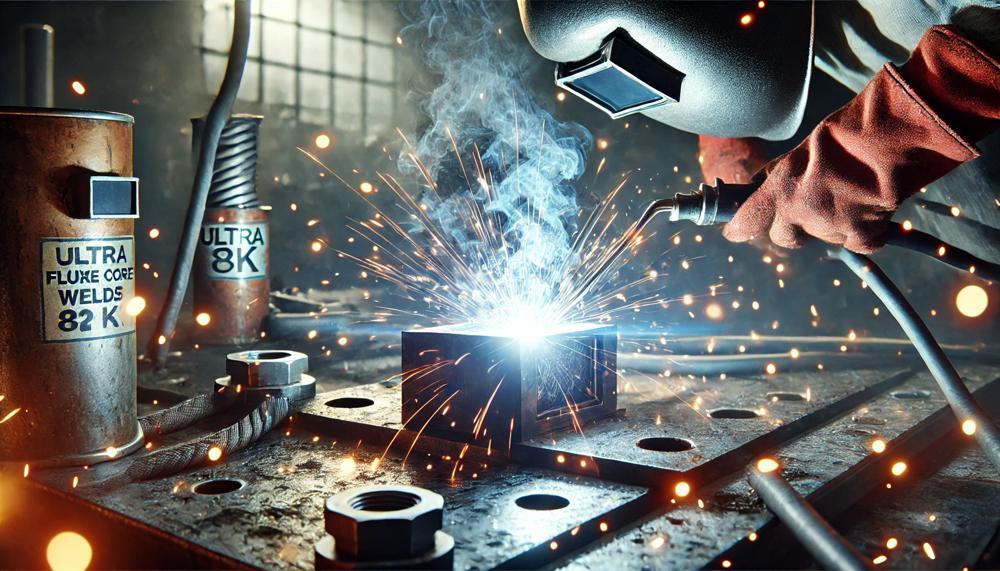When it comes to the world of welding, the debate on the efficacy and strength of various methods is as heated as the torches used. Flux core welding, often shadowed by its more traditional counterparts, actually holds a trove of benefits and robustness that many overlook. In this piece, we’re diving deep into the heart of flux core welding to shed light on its true capabilities and why it’s a contender not to be underestimated. Here’s what you’ll uncover:
- The Science Behind Flux Core Welding: Understanding what sets it apart from other welding techniques and how this impacts its strength.
- Comparative Strength Analysis: How do flux core welds stack up against other types of welds in terms of durability and load-bearing capacity?
- Practical Advantages: Beyond just strength, exploring the versatility and efficiency that make flux core welding a go-to for many professionals.
- Real-World Applications: Highlighting scenarios where flux core welding shines, backed by examples from industries that rely on its strength.
Join us as we cut through the noise and lay bare the facts about flux core welding’s strength, proving that it’s not just about how strong the weld is but how the method amplifies efficiency, versatility, and reliability in the most demanding of applications.
Contents
What Is Flux Core Welding?
Flux core welding, or FCAW (Flux-Cored Arc Welding), is a robust and adaptable welding approach well-suited for various applications. Unlike traditional methods, this technique utilises a special tubular wire filled with flux. This self-protecting wire eliminates the need for an external shielding gas, enabling outdoor use without the worry of wind dispersing the protective gas shield.
Differences Between Flux Core Welding and Traditional Welding Methods
| Feature | Flux Core Welding | Traditional Welding (e.g., MIG, TIG) |
| Shielding Gas | Not required as the flux in the wire creates its own shield. | External gas needed, usually argon or CO2. |
| Environment Suitability | Excellent for outdoor use; resistant to wind. | Best in controlled environments; wind can disperse shielding gas. |
| Material Thickness | Great for thicker materials due to deep penetration. | More suited for thinner, more delicate materials. |
| Weld Appearance | Often rougher with slag needing removal. | Cleaner and more aesthetically pleasing finishes. |
| Learning Curve | Simpler to learn with a more forgiving nature. | Requires more skill and practice for proficiency. |
| Speed | Higher due to continuous wire feed and high heat output. | Varies, generally slower due to precise control needs. |
In essence, flux core welding shines in its flexibility, cost-effectiveness, and suitability for rougher, outdoor conditions. In contrast, traditional welding methods like MIG and TIG offer cleaner finishes and are preferable for thin materials and controlled environments.
Strength Of Flux Core Welding

The strength of flux core welding stands out when pitted against other welding techniques, offering a unique blend of durability and efficiency crucial for heavy-duty applications. Here’s a detailed breakdown:
| Feature | Flux Core Welding | Other Welding Techniques (e.g., TIG, MIG) |
| Penetration Depth | Deep penetration, ensuring robust joint strength. | Varies; TIG has shallower penetration compared to flux core. |
| Material Thickness | Ideal for thicker materials, excelling in structural projects. | Best suited for thinner materials, offering precision. |
| Outdoor Suitability | Highly effective outdoors, impervious to wind and environment. | Less effective, as shielding gas can be disrupted by wind. |
| Learning Curve | Relatively easy for beginners, with a straightforward technique. | Varies; TIG requires more finesse and skill. |
| Cost-Effectiveness | More cost-effective due to no need for external shielding gas. | Can be costlier due to the need for gas and cleaner finishes. |
| Welding Speed | Higher deposition rates, making it faster for thick sections. | Generally slower, especially TIG, due to meticulous detail. |
Flux core welding shines in its robustness, adept at handling hefty loads and stress, making it a top pick for industrial and outdoor projects. While other techniques like TIG offer neater finishes and are more suited for delicate work, the raw strength and adaptability of flux core welding are unmatched for more rugged tasks.
Factors Affecting Strength
The key factors that can impact the strength of flux core welds are quite the ensemble, ranging from the craftsmanship of the welder to the conditions under which the welding is performed. Each factor plays a pivotal role in determining the final integrity and durability of the weld. Here’s a breakdown:
| Factor | Description | Impact on Weld Strength |
| Quality of Welding Wire | The wire’s composition and flux core consistency. | Directly influences weld metal properties and defect rate. |
| Weld Size | Includes both the depth and width of the weld. | Larger welds can provide greater strength but require careful heat management to avoid defects. |
| Materials Being Welded | The type and compatibility of base materials. | Material properties such as thickness and cleanliness affect weld penetration and bond strength. |
| Welder’s Skill Level | Experience and proficiency in flux core welding techniques. | Expertise is crucial for optimal parameter settings and technique, reducing defects and ensuring a strong weld. |
| Welding Conditions | Environmental factors including temperature, humidity, and wind. | Adverse conditions can affect shielding gas coverage and cooling rates, leading to porosity and other weaknesses. |
Flux core welding, with its knack for handling robust tasks, thrives when these factors are meticulously balanced. The quality of the welding wire sets the stage, ensuring the weld starts with the best possible materials.
The size of the weld then plays into the narrative, speaking volumes about the strength and integrity of the joint. The saga continues with the materials being welded, where compatibility and preparation are key. Yet, it’s the welder’s skill—a blend of art and science—that brings it all together, navigating through varying conditions to produce welds that are not only strong but also dependable.
Comparing Flux Core Welding To Other Methods
In the realm of welding, flux core welding stands out for its robustness and adaptability, making it a go-to choice for many heavy-duty applications. Let’s dive into the specifics of how the strength of flux core welds measures up against other welding techniques.
Flux Core Welding Versus Other Welding Methods: A Strength Comparison
| Welding Method | Strength and Durability | Key Considerations |
| Flux Core Welding (FCAW) | High | Deep penetration, shielding agent improves strength |
| TIG Welding | Medium to High | Requires greater skill, cleaner weld but lower deposition rate |
| MIG Welding | Medium | Less smoke than FCAW, versatile, but less penetration |
| Stick Welding (SMAW) | Medium to High | Portable, versatile, but requires more clean-up |
Diving Deeper into the Strength of Flux Core Welds
Flux core welding, with its nifty flux-filled wire, not only creates a protective shield but also dives deep into the base material. This method achieves a bond that’s not only sturdy but ready to tackle the toughest jobs out there. Compared to its counterparts, like TIG welding, flux core brings a bit more muscle due to its deeper penetration and the protective environment created by the flux, leading to stronger, more resilient welds.
While TIG offers precision and beauty, it doesn’t always hit the same strength levels as flux core, especially in thicker materials. MIG and stick welding have their own charms, offering a balance between strength, versatility, and ease of use. However, when the going gets tough, flux core welding’s deep penetration and robust shield mean it often pulls ahead in the strength stakes.
Key Takeaways for Welders
Whether you’re a seasoned welder or just starting, understanding the unique strengths of flux core welding is crucial. It’s not just about the power of the bond but knowing that with the right wire, settings, and a bit of skill, you can achieve welds that stand the test of time.
Real-world Applications And Strength Testing
In the realm of real-world applications, the robustness of flux core welds is paramount, ensuring structures withstand the test of time and stress. Here’s how these vital joints are scrutinized for their mettle:
Visual Inspection
A straightforward yet revealing approach, visual inspection checks for cracks, porosity, and proper fusion. Though it appears simple, it demands a keen eye and experience.
Bend Tests
These are the true tests of flexibility and strength, where a welded sample is bent to a specific angle. It’s a direct, hands-on method to gauge the integrity of a weld, looking for signs of failure or weakness.
Tensile Testing
In this rigorous analysis, a sample weld is pulled apart until it breaks. The force required to do so measures the weld’s strength, providing a numerical value to its tensile prowess.
Charpy V-notch Testing
This test assesses the toughness of the weld, particularly its ability to absorb energy at various temperatures. It’s crucial for applications where the welds must endure impact or sudden stress.
Radiographic and Ultrasonic Testing
For a glimpse beneath the surface, these non-destructive testing methods use X-rays or ultrasound to detect internal flaws. They’re indispensable for ensuring the internal quality of a weld without damaging it.
| Testing Method | Purpose | Benefits |
| Visual Inspection | Surface flaw detection | Quick and cost-effective |
| Bend Tests | Strength and flexibility | Direct assessment of mechanical integrity |
| Tensile Testing | Measure tensile strength | Quantitative data on weld strength |
| Charpy V-notch Testing | Impact toughness | Assesses performance under dynamic loads |
| Radiographic and Ultrasonic Testing | Internal flaw detection | Comprehensive insight without damage |
These methodologies, grounded in the keen observation and scientific principles, serve as the bulwark against failure in structures relying on the might of flux core welding.
Advancements In Flux Core Welding For Strength
Flux core welding, a robust method admired for its potency and efficiency, has seen significant advancements, contributing substantially to the strength of welds. Below, we detail these enhancements and their impacts.
Key Advancements and Their Effects:
- Improved Wire Composition: Modern flux core wires contain a mix of elements designed to enhance strength, durability, and consistency of welds. Innovations in chemical formulations result in better grain structure of the weld metal, offering higher tensile strengths.
- Advanced Welding Equipment: The evolution of welding machines with better control and stability allows for more precise, deeper penetration welds. This ensures that the bond between the materials is stronger and more reliable.
- Enhanced Shielding Gas Blends: Although flux core welding can be performed without external shielding gases, advancements in gas technology have led to blends that further stabilize the arc and reduce porosity, leading to denser, stronger welds.
- Skill and Training: As techniques evolve, so does the training of welders. Better-educated welders can produce consistently high-quality, stronger welds, understanding the nuances of modern flux core welding.
Comparison Table: Old vs New Techniques
| Aspect | Traditional Flux Core Welding | Advanced Flux Core Welding |
| Wire Composition | Standard elements, basic formulations | Enhanced elements, complex formulations |
| Equipment | Basic control, moderate stability | Precise control, high stability |
| Shielding Gas | Not applicable or standard | Advanced blends for improved results |
| Welder Training | Standard procedures | Advanced techniques and understanding |
Impact on Strength:
These advancements have directly impacted the strength and reliability of flux core welds, addressing limitations while boosting their application in demanding environments. The meticulous attention to wire composition, enhanced equipment functionalities, sophisticated gas blends, and improved welder expertise culminate in superior weld strength.
In practice, these enhancements mean structures and components welded with advanced flux core techniques exhibit better performance under stress, resist deformation and failure, and ultimately, extend the service life of welded assemblies.
Considerations For Optimizing Strength
When it comes to fortifying the backbone of our constructions with flux core welds, a keen eye for detail and a dash of welding wisdom are paramount. The pursuit of achieving the mightiest of bonds through welding calls for a cocktail of considerations, each playing a pivotal role in the dance of durability and strength. Let’s break down these elements with precision, akin to the fine art that welding truly is.
- Choice of Welding Wire: The sinew of your weld, the welding wire, is more than just a filler; it’s the very essence that decides the fortitude of your join. Opt for high-grade, compatible wire that whispers sweet promises of strength to the metals it unites.
- Size Does Matter: In the realm of welds, size is a double-edged sword. A larger weld carries the might of a giant, yet it demands more from you – time, material, and a steady hand. Balance is key; wield it wisely.
- Matchmaking Metals: Not all metals flirt the same way with flux core wires. The alchemy of welding requires a match made in metallurgical heaven. Ensure your flux core wire is the perfect suitor for the materials you’re joining, ready to bond them in unbreakable matrimony.
- The Artisan’s Touch: A weld is only as strong as the hands that forge it. Mastery in maneuvering the welder, understanding the arc’s whisper, and the precision in pace and pressure are what sculpt a mere join into a stronghold.
- Conditions of Concoction: The stage on which you perform your welding wizardry matters. Ventilation isn’t just about the air you breathe; it’s about setting the scene for a flawless fusion, free from the meddling of impurities.
- The Shielding Spell: Flux core welding, with its shielding sorcery, outshines TIG in the thick metal theatre. Yet, this magic blooms fully only under the right incantations of technique, wire, and conditions.
Conclusion
The strength and versatility of flux core welding emerge as a beacon in the robust landscape of welding technologies. Standing tall against traditional methods, its merits in durability, efficiency, and adaptability paint a picture of reliability for those navigating the demands of heavy-duty applications. Flux core welding, with its distinctive approach of utilizing a self-protecting wire, sidesteps the need for external shielding gas, making it an invaluable ally in the face of outdoor challenges where the wind might otherwise scatter a protective gas shield. This method shines not just in its formidable penetration depth and suitability for thicker materials, but also in its ease of learning and speed, marking it as a first-rate option for both professionals and novices alike.
Through a lens that examines practical advantages, real-world applications, and the science that underpins this technique, it becomes clear that flux core welding holds a firm ground. Its strength, compounded by advancements in wire composition and welding equipment, supports a wide array of industrial applications, proving its mettle where toughness is non-negotiable. Furthermore, the skill of the welder and the conditions under which welding takes place play critical roles in harnessing the full potential of flux core welding’s strength.
As we reflect on the journey through the intricacies of flux core welding, it’s evident that its prowess extends beyond mere strength.





